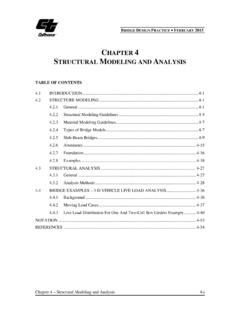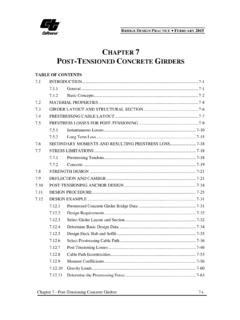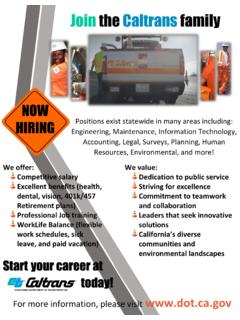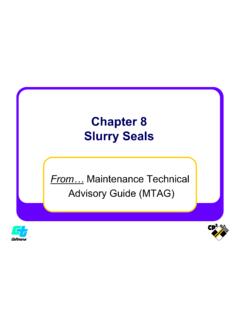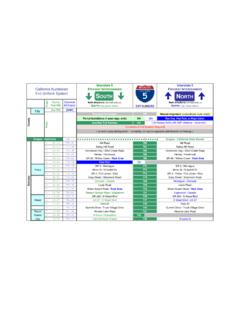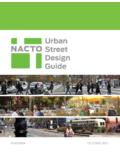Transcription of Bridge Rails and Barriers - California Department of ...
1 Bridge Rails and Barriers A Reference Guide for Transportation Projects in the Coastal Zone Introduction Photo: David Eppstein Background T he mission of the California Department of Transportation (Caltrans) is to improve mobility across California . To that end, Caltrans is responsible for the design , construction, operation, and maintenance of the state transportation network. The Caltrans Strategic Plan sets goals of providing the safest transportation system in the nation for the traveling public and Caltrans workers, maximizing transportation system performance and accessibility, efficiently delivering quality transportation projects and services, preserving and enhancing California 's resources and assets, and promoting quality service through an excellent workforce. Caltrans pursues these goals in accordance with current engineering, environmental, and economic regulations and policies. The mission of the California Coastal Commission (Commission) is to protect, conserve, restore, and enhance environmental and human-based resources of the California coast and ocean for environmentally sustainable and prudent use by current and future generations.
2 The Commission, in partnership with coastal cities and counties, plans and regulates the use of land and water in the coastal zone. The terrestrial component of the coastal zone varies in width from several hundred feet in urban areas to more than 5 miles in some rural areas. Development projects (including transportation projects) in the coastal zone generally require a coastal permit from either the Commission or a local jurisdiction with a Commission-certified local coastal program (LCP). In addition, projects must meet the requirements of the federal Coastal Zone Management Act of 1972. As the state Department responsible for the transportation infrastructure in California , Caltrans is often involved in projects in the coastal zone. Consequently, such projects must satisfy the requirements of Caltrans' mission and regulations, as well as the policies of the Coastal Act. In designing projects, Caltrans is guided by a rigorous and comprehensive body of specifications set forth in the Highway design Manual, which is supplemented by an array of documents published by the American Association of State Highway and Transportation Officials (AASHTO) and the Federal Highway Administration (FHWA).
3 The Commission's review of plans and development proposals is guided by the provisions set forth in the California Coastal Act of 1976 (Coastal Act), which are implemented through the Coastal Commission's planning and regulatory programs. Local government review of transportation projects in the coastal zone is guided by the pertinent Commission-certified LCP. policies, together with the public coastal access policies of the Coastal Act. The design process is the meeting place of engineering, resource protection, and aesthetic considerations that must be evaluated by both Caltrans and the Commission. Consequently, an effective working partnership between the two entities is important for both to meet their common mandate of serving the people of California . Successful collaboration early in the design process can assist both entities not only in meeting their statutory responsibilities, but also in fostering the creation of a modern multimodal transportation network that complements the spectacular resources natural, cultural, and visual of the state.
4 Bridge railings and Barriers in the coastal zone have presented a distinct set of challenges, largely because the visual protections established by the Coastal Act reach beyond the structural considerations that have traditionally driven Caltrans design practices. To help address these challenges, the Commission appointed a Road's Edge Subcommittee of two members to work with Caltrans and Commission staff in providing input on selected Bridge railings and related features prior to the permit approval stage. The Subcommittee's review normally occurs after the development of substantial information, primarily through the development of environmental documents and related technical reports, and after Caltrans and Commission staff have worked together to sort out more basic project considerations such as the Bridge /roadway alignment and structural alternatives. Although the Subcommittee cannot bind a future decision of the Commission, the Commission carefully weighs the Subcommittee's input when projects reach the permit approval stage.
5 But perhaps more importantly, the Subcommittee functions as a resource for design review facilitating collaboration, efficiency, and resolution of potential conflict at earlier phases of project development. To support this process, Caltrans, in collaboration with the Commission, has developed a number of railing and barrier designs that have met or exceeded Caltrans' standards; several have received coastal development permit approvals. With the application of each new railing, Caltrans and Commission staff continue to learn more about the positive and negative features of the various designs in different settings. This reference guide presents, in a single, user- friendly format, a digest of the currently available palette of railing and barrier types that may be suitable for adapted use in future projects in the coastal zone. Not all of the railing and barrier types contained in this guide would be appropriate for all types of projects in all locations.
6 The ultimate choice of railing or barrier type for any particular project must be sensitive to the regional and site-specific context. Ensuring a general sense of visual cohesion and compatibility within regional corridors is another important factor in the selection of railing types. Early consultation between Caltrans and Commission staff is recommended to determine a subset of railing and barrier types contained in this reference guide that might be appropriate to consider for any given project. How to Use this Guide T his guide has been prepared as a tool to help stakeholders and participants in Bridge and railing design to better understand options available for potentially successful application in future projects. Hopefully, this information will help to streamline the processes of rail selection and coastal development permitting. Part II, Rails and Barriers , presents fundamental design standards as well as a wide array of rail examples of (both preliminary designs and final selections) exhibiting site-specific features; aesthetic designs and treatments; and design features to ensure safety, ease of maintenance, and versatility.
7 The successful combination of these characteristics supports compatibility and compliance with both Caltrans standards and Coastal Act/LCP policies. Several examples in this document reflect projects that have been approved, and in some cases already constructed, in the coastal zone. As noted above, not all of the railing and barrier types contained in this guide would be appropriate for every project. Furthermore, some of the built examples provide useful guidance for potentially improving railing designs in future applications. Again, while the use of railings depicted in this document does not guarantee coastal development permit approval for any given project, since each project must be evaluated within its specific context, this compilation represents the currently available palette of railing types that may be successfully tailored for upcoming projects. Part III, Reference Material, is a list of sources and links that provide additional in-depth information for more detailed study and project development.
8 Most of the railings and Barriers shown here are standard railings or variations of standard railings already in use by Caltrans. This palette is not meant to be viewed as an exhaustive list;. other designs, appropriate to project-specific contexts, are encouraged for future projects, so long as they meet the applicable design standards of both Caltrans and the Commission. To ensure context-sensitive compatibility, final rail selection should consider applicable Coastal Act/LCP. policies, site-specific features, and aesthetics of the structure. It is anticipated that the range of available railing and barrier options will continue to increase as additional designs that meet the criteria of the two entities are developed and implemented, and as the relative success of new and different approaches can be evaluated over time. Moreover, it is anticipated that this compilation will ultimately be updated to include a palette of railings and Barriers (including median Barriers ) for off- Bridge use in the coastal zone, and possibly evolve into a guide that addresses a broader spectrum of road edge treatments in the coastal zone.
9 To create successful design options, it is important that Caltrans project teams familiarize themselves with the appropriate Coastal Act/LCP policy provisions specific to the project location as early as possible in the project development process. Close collaboration with Commission and LCP staff and, as appropriate, the Road's Edge Subcommittee, at key stages in the process promotes understanding of these policies and facilitates development of approvable Bridge railing design and selection of options. Caltrans district offices often work with design review committees at the local level, and it is likewise important that those efforts to develop context-sensitive designs are well informed of the LCP and Coastal Act policies that will be the standards of review for coastal development permit proposals. Throughout the design development process, it is important to incorporate the coastal policy guidance as Caltrans'. project teams develop safe and creative options that adhere to the Department 's structural and design parameters for coastal zone settings.
10 Bridge Railing design Considerations T he determination of a Bridge project's form and function is driven by its location and the character of the use to which it will be subject. The science of developing a project's form and function is the product of years of expertise in varied geographies and adherence to the most current standards and practices in the relevant engineering fields. This aspect of project development is common to all Bridge projects wherever they may occur. Beyond the essential form and function, the visual and aesthetic effects of the Bridge on its surroundings are of singular concern to the designer. Bridge projects in the coastal zone, as discussed earlier, must be consistent with state and local coastal program policies to receive the necessary regulatory approvals. Accordingly, the Commission's policy context is addressed first below, with the understanding that the aesthetic accommodations must be compatible with the engineering standards to which Caltrans is required to conform.

